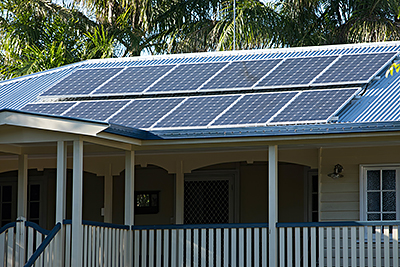What is solar energy?
Solar energy is light and heat from the sun.
Solar energy technology can capture this energy and convert it into electricity or use it to heat air or water. Most solar energy in Queensland is converted into electricity and used to help power the grid.
Solar energy is renewable and sustainable. Some of the benefits of solar energy include:
- reducing electricity bills
- low maintenance costs
- reduce dependence on non-renewable sources of energy
- reduce carbon footprint.
Solar energy technology
The are 2 main types of solar energy technology:
- concentrated solar thermal (CST)
- solar photovoltaic (solar PV).
CST uses a field of mirrors to reflect sunlight on to a receiver, which transfers the heat to a thermal energy storage system.
Typical solar PV cells are covered in glass and protected by aluminium frame, collectively known as a solar panel. The panels can convert sunlight directly into electricity.
Solar PV is currently the most used solar technology in Queensland.
Technology is improving, with flexible solar PV roof tiles now available and solar paint in development.
Efficiency and reliability
The efficiency of solar PV (how much solar energy is converted into electricity) depends on the types of cells. Monocrystalline cells and polycrystalline cells are very efficient.
As they don’t have any internal moving parts, solar panels are generally reliable and low maintenance, but their output (efficiency) depends on a few factors, including:
- location
- size
- installation.
Queensland has more than 300 days of sunshine every year, but solar panels don’t need direct sunlight to work.
Even on a dark, cloudy day, light reflected from the sky are absorbed to create 10–25% of their normal output.
For maximum efficiency and reliability, solar panels should not be placed in shade from trees, buildings or other structures.
Recycling
Up to 95% of the materials used in a solar panel can be recycled.
Silicone solar panels primarily consist of plastic, glass and aluminium, all of which can be repurposed in large volumes.
The Queensland Government and Smart Energy Council is developing an Australian-first pilot program to best recycle PV solar panels. The program will investigate collection and disposal of unwanted residential, commercial and large-scale solar panels.

Rooftop solar
Queensland has the highest rate of household solar installations in Australia, with 1-in-3 homes using solar.
Altogether, more than 877,000 small businesses and homes now have rooftop solar. On average, around 140 new rooftop PV systems are installed across Queensland every day.
Learn more about installing solar in your home.
Cost benefits
The cost to install a solar PV network can be offset over several years by not having to pay traditional power bills. Households may also be eligible for interest-free government loans for installation.
These benefits don’t take into account government rebates or subsidies for households and small businesses, which represent a huge saving over a rooftop system’s 25– to 30–year lifespan.
Maintenance and lifespan
Solar panels don’t contain moving parts, which means you don’t need to do anything special to keep them running.
Most quality solar panels are designed to be self-cleaning in the rain. Dust, debris and bird droppings can accumulate when there hasn’t been rain and reduce the amount of electricity produced.
The general recommendation is to have your panels cleaned by a professional once a year.
The average lifespan for a rooftop solar PV system is 20–30 years with proper maintenance. Near the end of a panel’s life, its efficiency can drop by 12–15%. The inverter responsible for converting Direct Current (DC) from the panels into Alternating Current (AC) may need replacing after 10–15 years of use.
- Last updated
- 10 March 2025